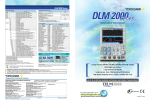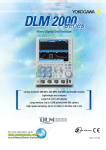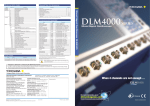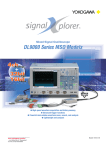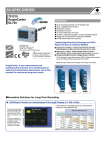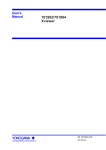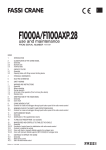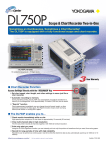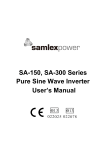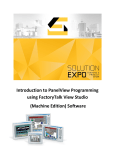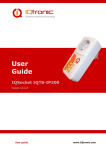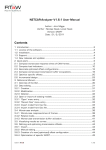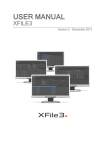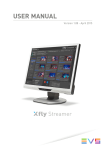Download - Yokogawa
Transcript
Precise control and flexibility DLM2000 Series Mixed Signal Oscilloscopes Bulletin DLM2000-E-E tmi.yokogawa.com The DLM2000 embodies everything a user would expect in an oscilloscope. It’s a family of products that goes beyond the demands and needs of users. Typical of a company focused on quality, the DLM2000 has been built to last decades, crafted by engineers to meet current demands and future proofed to keep track with the ever rapid changes in technology. A product designed for the future but at today’s prices. The DLM2000 is a series of bench-top oscilloscopes made for electronic design and debug. It’s ergonomic, easy to use, and complete with all the features and more you would expect in today’s oscilloscope. With bandwidths from 200 to 500 MHz and memory from 1 to 250 MPoints, there is a DLM2000 to meet your application and budget. Why choose the DLM2000? Quality – As a bench-top instrument, an oscilloscope is the most used piece of test and measurement equipment. To meet the rigors of everyday use it needs to be reliable. Yokogawa’s reputation for high quality products ensures the user is never let down and can depend on the DLM2000 Innovation – The ever increasing demands of today’s test needs means oscilloscopes must be versatile and adapt to all sorts of different applications. Yokogawa’s DLM2000 series is equipped with all the features and more that an engineer requires in an oscilloscope. Foresight – Users experience a short learning curve thanks to an intuitive man-machine interface that is easy to use. Keeping in touch with users has ensured that any Yokogawa product introduced to the market has been developed with their needs in mind. Why choose Yokogawa Why choose Yokogawa Our passion for measurement Yokogawa believes that precise and effective measurement lies at the heart of successful innovation – and has focused its own R&D on providing the tools that researchers and engineers need to address their challenges both great and small. Our heritage Yokogawa has been developing measurement solutions for almost 100 years, consistently finding new ways to give R&D teams the tools they need to gain the best insights from their measurement strategies. Our oscilloscope design has been led by customers looking for ease-ofuse and functionality. Our commitment Yokogawa takes pride in its reputation for quality, both in the products we deliver – often adding new features in response to specific client requests – and the level of service and advice we provide to our clients, helping to devise measurement strategies for even the most challenging environments. Precise control DLM2000 Series Precise control 4 Easy to use portrait design The large display of a DLM2000 is located above the controls; this enables it to be nearer the eyes of the user and keeps the footprint on the bench to a minimum. The intuitive controls are laid out so that a user can see at a glance what channels and features are switched-on and quickly make the measurements that are needed. Easy to configure 8.4 inch display Users can automatically or manually split the display to separate individual channel waveforms while maintaining their full resolution and dynamic range. It is therefore easy to see the details of all signals regardless of the number of channels in use. 8 1 2 3 4 5 6 7 8 9 10 Horizontal Position and Scale Knob Dedicated Zoom Keys Four-Direction Selector Button Select key moves the cursor up/down/left/right Jog Shuttle and Rotary Knob 9 10 Logic input connector 3 Trigger Control Keys and Level Knob Vertical Position and Scale 7 1 6 2 4 Large screen in a compact body Snapshot key to freeze traces on-screen Graphical on-line help key Built-in manual 5 Fast and flexible 5 Fast and flexible Flexible MSO input Choose to capture a mix of analog and more digital signals. With a push of a button, channel 4 converts into 8 digital inputs and the DLM2000 becomes a mixed signal oscilloscope. This makes it possible to view 3 analog and 8 digital signals simultaneously and view more control and logic signals. Digital channels can also be used to analyze I2C, SPI and UART serial buses which keep the analog channels available for other signals. ScopeCORE fast data processing The hardware optimized architecture and dedicated ScopeCORE IC in the DLM2000 enable measurements and signal processing to be carried out in real time. This means that turning on more channels does not affect the waveform acquisition rate and measurements are always performed at high speed. 3 channels analog + 8-bit logic The fast ScopeCORE internal processor DLM2000 series Lineup Model Analog Bandwidth DLM2022 200 MHz DLM2024 200 MHz DLM2032 350 MHz Maximum sample rate 2.5GS/s with Interleave on No of channels Maximum record length (in single measurement mode and with interleave on) 2 analog 62.5 MPoints 4 analog or 3 analog plus 8 digital 250 MPoints with /M3 option 2 analog 62.5 MPoints DLM2034 350 MHz 4 analog or 3 analog plus 8 digital 250 MPoints with /M3 option DLM2052 500 MHz 2 analog 62.5 MPoints DLM2054 500 MHz 4 analog or 3 analog plus 8 digital 250 MPoints with /M3 option The flexibility of longer memory DLM2000 Series The flexibility of longer memory 6 Long waveform memory History memory and high speed acquisition Up to 250 MPoints The two advantages of a long waveform memory are the abilities to capture for long periods of time and to maintain high sample rates, and hence higher effective measuring bandwidths for all time base settings. Capture and replay up to 50,000 acquisitions With the history memory, the DLM2000 can capture and replay up to 50,000 individual acquisitions. These can be displayed one at a time or as an accumulation. Using the search and measurement functions, abnormal signals can therefore be quickly isolated, analyzed and precisely categorized without needing to carefully configure triggers to capture rare events. With the maximum memory installed (/M3 option), in single shot mode, a 10 kHz signal lasting for more than one hour can be captured. The same memory can capture a 200 millisecond signal at a sample rate of 1.25GS/s sample rate. Maximum memory per channel Type of Two analog measurement channel models Four analog channel models Continuous 6.25 MPoints 6.25 MPoints (standard memory) 12.5 MPoints (with /M2 option) 25 MPoints (/with M3 option) Single-shot using all analog channels 25 MPoints 25 MPoints (standard memory) 62.5 MPoints (with /M2 option 125 MPoints (with /M3 option) Single-shot using half the analog channels 62.5 MPoints 62.5 MPoints (standard memory) 125 MPoints (with /M2 option) 250 MPoints (with /M3 option) Together with a maximum continuous acquisition rate of 20,000 waveforms per second, which increases to approximately 450,000 in N Single mode, the history memory in the DLM2000 enables abnormal signals to be captured without needing to know what makes them different. Waveform history Abnormal signal Reliable triggering 7 Reliable triggering When just a specific event or abnormal waveform needs to be captured, the flexible and reliable triggering of the DLM2000 is the solution. The user can combine analog and digital inputs and select the trigger conditions appropriate to the complexity and uniqueness of the event. Enhanced triggers Trigger on arbitrary serial bus patterns Via the Enhanced menu, the DLM2000 can be set to trigger, for example, on an edge of any channel, an edge or state when conditions on other channels are met or when the width of a pulse is either more or less than a specified time. Dedicated triggers are also available for serial bus options. In order to support any type of serial bus and thus the ability to trigger on any combination of ID and data etc., a user define trigger is provided. On one input channel, a pattern of up to 128 bits can be set and other channels can also be used for clock, chip select and latch signals. Edge trigger Edge Enhanced triggers Edge OR Edge (qualified) State HHHH-LHLH-LLLL (Arbitrary pattern) Trigger Combination triggers Via the B trigger menu two serial bus triggers can be combined, which means that the DLM2000, for example, will trigger when signal conditions on either a CAN bus or a LIN bus are met. Pulse width State width Serial(optional) CAN/LIN/UART/I2C/SPI (standard) user defined TVNTSC/PAL/SDTC/ HDTV/user defined B triggers A Delay B A to B (n) Dual bus (combination trigger of 2 serial busses) LIN CAN Input signal A CAN Input signal B LIN The “A to B(n)” trigger provides the ability to trigger when a specific number of edges has occurred on input B. This enables measurements on signals with shifted timing, such as nonstandard video signals, and motor reference position pulses and drive pulses to be easily made. Input signal A Input signal B Triggering on the 7th edge of the B input signal Trigger Features and benefits DLM2000 Series Features and benefits Capable measurement and analysis The DLM2000 is packed with advanced capture and analysis features to provide quick and comprehensive answers. Real time filters and post processed digital filters Two fully independent zoom windows Advanced waveform search functions Automatic parameter measurement and statistical analysis The DLM2000 has two types of filter. Real time input filters, with cut-offs from 8 kHz to 200 MHz, are selectable for each channel and the filtered data is stored in the internal memory. Input waveforms can also be filtered using a digital IIR filter using the mathematics (MATH) function. This method enables the input and filtered waveforms to be simultaneously displayed and compared. High and low pass filters from 0.01 Hz to 500 MHz are selectable with a high level of precision. Combined with the advanced search and cursor/parameter measurement capabilities, the two zoom windows enable users, for example, to see the waveform detail of two parts of the acquisition which can be separated by a long time period. It is thus possible to quickly find, measure and analyze the details of the cause and effect of an abnormality which could be on the same or different input channels. They also make it possible to view and compare the details and timings of different serial buses which are running at different speeds. Quickly find and mark abnormal signals in long and multiple waveform acquisitions. 30 waveform parameters from a total of 29 different types can be displayed simultaneously with a high update rate. These include: maximum, minimum, peak-to-peak, pulse width, period, frequency, rise and fall times, and the delay between channels. The image shows the snapshot function which freezes traces on the screen to compare old and new acquisitions. Single waveform acquisitions of up to 250 MPoints can be searched using various criteria such as edges, state patterns, pulse widths and serial bus patterns (optional). The history memory can be searched to find matching criteria in up to 50,000 acquisitions. The statistics of repetitively measured parameters can also be displayed, such as the mean, maximum, minimum and standard deviation. Additionally, the Go/NO-GO function can be used to test the results of parameter measurements, trigger conditions and other criteria and automatically save or print data, send an e-mail etc. 8 Features and benefits 9 Parameter trend and histogram displays Automatically measure time and voltage differences FFT frequency domain analysis User define math To observe the fluctuations of measured parameters, it is possible to display them as trends. Period-to-period changes can then be easily seen. The variation of parameters can also be displayed as histograms thus providing a visual method of assessing them statistically. Line or waveform marker cursors can be placed on different displayed waveforms and the absolute values of voltage and time, and their differences, can be simply displayed. A degree cursor can also be used by converting the time axis into a position/degree axis. 2 FFT analyses can be performed simultaneously. The source data can be either from input channels or the results of mathematical computations. As well as standard Power Spectrum calculations, a full suite of FFT functions are available using the /G2 user define math option. Up to 2 math channels are available. The standard DLM2000 provides arithmetic and filtering functions on computations of up to 125 MPoints. By installing the /G2 option, the oscilloscope offers comprehensive user defined mathematics. Equations can be arbitrarily created using a suite of operators such as trigonometric and logarithmic operators, integration and differentiation, pulse width operators, phase measurement and digital to analogue conversion (in the image). When used in combination with cursor and automatic waveform measurements on the computed waveforms, the DLM2000 is able to provide meaningful results according to the user’s specific requirements. Serial bus triggering and analysis DLM2000 Series Serial bus triggering and analysis 10 Up to 4 buses simultaneously Power supply analysis options Dedicated trigger and analysis options are available for FlexRay, CAN, CAN FD, LIN, SENT, UART, I2C and SPI serial buses. The /G3 and /G4 options enable switching loss, joule integral (i2t), SOA (safe operating area), harmonics based on EN610003-2, and other power parameters to be measured and analyzed. From most buses a wide variety of trigger combinations can be set, including ID and Data combinations, which can also be combined with conventional edge triggers. A serial bus auto-setup enables the MSO to be quickly configured. The user therefore does not need detailed knowledge of the bus frame format. Analysis can be performed at high speed simultaneously on up to four different buses operating at different speeds. This is enhanced by the extensive search facilities, allowing the user to look for specific data in the very long memory. The dual-zoom facility means that different buses can be viewed and debugged alongside each other. Simultaneous analyses of I2C and SPI Four bus decode and list display Switching loss analysis Using the long memory, the switching loss of the voltage and current input waveforms can be computed (V(t) X i(t)) over long time periods. The turn-on/off loss, the loss including the continuity loss, and the loss over many cycles of the 50 Hz/60 Hz power line can be calculated and analyzed. Power measurement The MSO can also be used as a power meter by providing automated measurement of power parameters for up to two pairs of voltage and current waveforms, such as the active power, apparent power and power factor. These values can then be statistically processed and calculated. Switching loss analysis Power parameter measurement Connectivity 11 Connectivity 2 1 2 3 4 5 6 7 8 9 Ehernet (optional) Supports 1000BASE-T, 100BASE-TX, 10BASE-T. Go/No-Go output terminal TTL level output of the result of the GO/No-GO function. RGB video signal output terminal Check the image of the waveform on a external monitor. USB-PC connection terminal Enables control from a PC. USB perpheral connection terminal Supports USB storage, USB keyboards, USB printers. Probe power terminal (optional) Power supply for current and differential probes. GP-IB connection terminal (optional) Enables control from a PC. External trigger input An input for a trigger signal separate from the channel signals. Trigger output Output a CMOS 3.3V level trigger signal 1 6 3 4 7 5 8 9 1000BASE-T/100BASE-TX/10BASE-T Hub or router * Hub or router * Sends waveform, screen, and settings data Remote control Mail transmission (GO/NO-GO action) USB (standard on rear panel) Ethernet (/C10, /C11 options) DLM2000 Supports USB: *DLM2000’s internal storage can be recognized by a PC as an external USB storage device. Transferring files is easy even when a USB thumb drive can’t be used. Sends waveform, screen, and settings data Remote control Comprehensive software tools DLM2000 Series Comprehensive software tools A comprehensive suite of software tools to support and complement complex measurement tasks. Free XviewerLITE Off-line waveform display and analysis Waveform monitoring on a PC Data transfer to a PC Basic display and measurement Provides zooming, vertical cursors and data conversion to CSV format. Xwirepuller The DLM2000 can be simply controlled using a PC and mouse via an Ethernet, USB, or GP-IB interface. When the software program starts, a simulation of the oscilloscope appears on the PC display. Custom software development Xviewer Advanced analysis Xviewer can display acquired waveforms, transfer files and control instruments remotely. In addition to simply displaying the waveform data, Xviewer features many of the same functions that the DLM2000 offers; zoom display, cursor measurements, calculation of waveform parameters, complex waveform math and FFT. Binary waveform data can easily be converted to CSV, Excel or Floating Point Decimal format. LabVIEW drivers MATLAB toolkit By using the LabVIEW driver written for the DLM2000, a developer can dramatically reduce the amount of work required to enable a PC to control the instrument from within the LabVIEW environment. The MATLAB® tool kit can be used to control the DLM2000 and to transfer data via GP-IB, USB or Ethernet from within MATLAB. TMCTL library Command control Trial version available This DLL (Dynamic Link Library) enables Microsoft Visual studio programs, such as Visual C++ and Visual Basic, to be quickly developed to communicate between the PC and the DLM2000. It supports GPIB, USB and Ethernet interfaces. DLTerm The command line tool can be used with the TMCTL library to develop communication programs. Prototype code can be rapidly created to automate sequences of capture, measurement and analysis tasks before writing a fully custom software routine. Symbol editor Physical value symbol definition files for CAN serial bus analysis can be created and edited. CANdb files can also be imported. 12 Recommended Probes and accessories 13 Recommended Probes and accessories The extensive range of Yokogawa probes includes models which are designed and optimized for specific applications. For power electronics testing For serial bus testing PBC050 / PBC100 - Current probes* DC to 50 MHz / 100 MHz 30 Arms PBDH1000 – 1GHz differential probe 1 M ohm / 1.1pF input ±25 V differential voltage input Compatible with the FlexRay standard PBDH0150 - differential probe DC to 150 MHz 1400 V (DC +ACpeak) differential and common mode voltage 701920 / 701922 differential probes 500 MHz / 200 MHz ±12 V / ±20V differential voltage input Logic probes PBL100 / PBL250 8 bit logic probes 100 MHz / 250 MHz toggle frequency 1 M ohm / 100 K ohm input 701926 – differential probe* DC to 50 MHz 5000 Vrms / 7000 Vpeak PBA1000 1 GHz Active probe 100 k ohm / 0.9 pF input 701936 deskew correction signal source *Higher current and other differential probes are available. See page 16 Specifications Models DLM2000 Series Trigger type, trigger source Model name Frequency bandwidth DLM2022 (710105) 200MHz DLM2032 (710115) 350MHz DLM2052 (710125) 500MHz DLM2024 (710110) 200MHz DLM2034 (710120) 350MHz DLM2054 (710130) 500MHz Input terminal Max. sample rate 2 analog channels 1.25GS/s (interleave mode off) 4 analog channels / 3 analog channels + 8bit logic 2.5GS/s (interleave mode on) A triggers AB triggers Basic Specifications Analog Signal input Input channels Analog input Input coupling setting DLM20x2: CH1, CH2 DLM20x4: CH1 to CH4 (CH1 to CH3 when using logic input) 1 MΩ 1.0%, approximately 20 pF 50 Ω 1.0% (VSWR 1.4 or less, DC to 500MHz) Voltage axis sensitivity 1MΩ 2 mV/div to 10 V/div (steps of 1-2-5) setting range 50 Ω 2 mV/div to 500 mV/div (steps of 1-2-5) Max. input voltage 1 MΩ 150 Vrms 50 Ω Must not exceed 5 Vrms or 10 Vpeak 1 MΩ ±1V (2 mV/div to 50 mV/div) ±10V (100 mV/div to 500 mV/div) ±100V (1 V/div to 10 V/div) 50 Ω ±1V (2 mV/div to 50 mV/div) ±5V (100 mV/div to 500 mV/div) Max. DC offset setting range Trigger level setting range CH1 to CH4 ±4 div from center of screen CH1 to CH4 0.01 div (TV trigger: 0.1 div) CH1 to CH4 ±(0.2 div + 10% of trigger level) Trigger level accuracy Analog input Window Comparator Offset voltage accuracy*1 2 mV to 50mV/ div ±(1% of setting +0.2 mV) 100 mV to 500 mV/div ±(1% of setting + 2 mV) 1 V to 10 V/div ±(1% of setting + 20 mV) Display 1 MΩ (when using passive probe) 50 Ω DLM203x 8.4-inch TFT color liquid crystal display 1024 x 768 (XGA) Functions Waveform acquisition modes Normal, Envelope, Average High Resolution mode Max. 12 bit (the resolution of the A/D converter can be improved equivalently by placing a bandwidth limit on the input signal.) Sampling modes Real time, interpolation, repetitive sampling Accumulation Select OFF, Intensity (waveform frequency by brightness), or Color (waveform frequency by color) Accumulation time Roll mode DLM205x 100 mV to 100 V/div DC to 200 MHz DC to 350 MHz DC to 500 MHz 20 mV to 50 mV/div DC to 150 MHz DC to 300 MHz DC to 400 MHz 10 mV to 500mV/div DC to 200 MHz DC to 350 MHz DC to 500 MHz 2 mV to 5 mV/div DC to 150 MHz DC to 300 MHz DC to 400 MHz History memory 100 ms to 100 s, Infinite Enabled at 100 ms/div to 500 s/div (depending on the record length setting) Zoom function Frequency characteristics (-3 dB attenuation when inputting a sinewave of amplitude ± 3div)*1*2 DLM202x Center/Width can be set on individual Channels from CH1 to CH4 Display ±(1.5% of 8 div + offset voltage accuracy) DC accuracy*1 CH1 to CH4, Logic CH1 to CH4, Logic CH1 to CH4, Logic CH1 to CH4 CH1 to CH4 CH1 to CH4 CH1 to CH4 CH1 to CH4, Logic CH1 to CH4 10 ns to 10 s (Edge, Edge Qualified, State, Serial Bus) 1 to 109 (Edge, Edge Qualified, State, Serial Bus) Dual Serial bus only Trigger level setting resolution *1 AC, DC, DC50 Ω, GND Input impedance Serial Bus I2C (optional) SPI (optional) UART (optional) FlexRay (optional) CAN (optional) CAN FD (optional) LIN (optional) SENT (optional) User defined A Delay B A to B(N) Bus Two zooming windows can be set independently (Zoom1, Zoom2) Zoom factor x2 to 2.5 points/10div (in zoom area) Scroll Auto Scroll Search functions Edge, Edge Qualified, State, Pulse Width, State Width I2C (option), SPI (option), UART (option), CAN (option), LIN (option), Flexray (option) Max. data 10,000 (record length 1.25 kPoints, with /M1 or /M1S option) 20,000 (record length 1.25 kPoints, with /M2 option) 50,000 (record length 1.25 kPoints, with /M3 option) History search Select Rect, WAVE, Polygon, or Parameter mode Isolation between channels -34 dB@ analog bandwidth (typical value) Replay function Automatically displays the history waveforms sequentially Residual noise level*3 The larger of 0.4 mV rms or 0.05 div rms (typical value) Display Specified or average waveforms A/D resolution 8bit (25LSB/div) Max. 12 bit (in High Resolution mode) Cursor Types Bandwidth limit FULL, 200 MHz, 100MHz, 20 MHz, 10 MHz, 5 MHz, 2 MHz, 1 MHz, 500 kHz, 250 kHz, 125 kHz, 62.5 kHz, 32 kHz, 16 kHz, 8 kHz (can be set for each channel) ΔT, ΔV, ΔT & ΔV, Marker, Degree Snapshot Real time sampling mode Interleave OFF 1.25 GS/s Interleave ON 2.5 GS/s Parameter measurement Repetitive sampling mode 125 GS/s Max, Min, P-P, High, Low, Rms, Mean, Sdev, IntegTY+, IntegTY, +OVER, -OVER, Pulse Count, Edge Count, V1, V2, ΔT, Freq, Period, Avg Freq, Avg Period, Burst, Rise, Fall, +Width, -Width, Duty, Delay Statistical computation of parameters Min, Max, Mean, standard deviation, Count 2 ch model (/M1S) Repeat/Single/Single Interleave: 6.25 M/25 M/62.5 MPoints Statistics modes Continuous, Cycle, History Trend/Histogram display of wave parameters 4 ch model (/M1S) Repeat/Single/Single Interleave: 6.25 M/25 M/62.5 MPoints Up to 2 trend or histgram display of specied wave parameters Computations (MATH) 4 ch model (/M2) Repeat/Single/Single Interleave: 12.5 M/62.5 M/125 MPoints +, -, x, Filter (Delay, Moving Avg, IIR Lowpass, IIR Highpass), Integ, Count (Edge, Rotary), user defined math (optional) 4 ch model (/M3) Repeat/Single/Single Interleave: 25 M/125 M/250 MPoints Computable no. of traces 2 (Math1, Math2) (1 trace for 2ch model) Max. computable memory length /M1, /M1S option: 25 MPoints /M2 option: 62.5 MPoints /M3 option: 125 MPoints Reference function Up to 2 traces (REF1/REF2) of saved waveform data can be displayed and analyzed Modes: Rect, Wave, Polygon, Parameter Actions: Buzzer, Print, Save, Mail Maximum sample rate Maximum record length Currently displayed waveform can be retained on screen Computation & Analysis Functions Ch-to-Ch deskew ±100 ns Time axis setting range 1 ns/div to 500 s/div (steps of 1-2-5) Time base accuracy*1 ± 0.002% Max. acquisition rate*4 Approx. 20,000 waveform/sec/ch (Accumulation mode) Action ON trigger GO/NO-GO Dead time in N Single mode Approx. 2.2μs (approx. 450,000 waveforms/sec/ch) XY Displays XY1, to XY2 and T-Y simultaneously FFT Number of points: 1.25k, 12.5k, 25k, 125k, 250k Window functions: Rectangular, Hanning, Flat-Top FFT Types: PS (LS, RS, PSD, CS, TF, CH are available with /G2 or /G4 option) Histogram Displays a histogram of acquired waveforms User-defined math (/G2 option) The following operators can be arbitrarily combined in equations: +, -, x, /, SIN, COS, TAN, ASIN, ACOS, ATAN, INTEG, DIFF, ABS, SQRT, LOG, EXP, LN, BIN, DELAY, P2 (power of 2), PH, DA, MEAN, HLBT, PWHH, PWLL, PWHL, PWLH, PWXX, FV, DUTYH, DUTYL, The maximum record length that can be computed is the same as the standard math functions Logic Signal Input (4 ch model only) Number of inputs 8 bit (excl. 4 ch input and logic input) Maximum toggle frequency Logic probe 701988: 100 MHz Logic probe 701989: 250 MHz Compatible probes 701988, 701989 (8 bit input) (701980, 701981 are available) Min. input voltage 701988: 500 mVp-p 701989: 300 mVp-p Input range Model 701988: ±40 V Model 701989: threshold ±6V Max. nondestructive input voltage ±40 V (DC + ACpeak) or 28 Vrms (when using 701989) Threshold level setting range Model 701988: ±40 V (setting resolution of 0.05 V) Model 701989: ±6 V (setting resolution of 0.05 V) Input impedance 701988: Approx. 1 MΩ/approx. 10 pF 701989: Approx. 100 kΩ/approx. 3 pF *1 Maximum sampling rate Maximum record length Power supply analysis (/G3, /G4 option) Power analysis Switching loss Total loss / switching loss, power waveform display, Automatic measurement and statistical analysis of power analysis items (Wp, Wp+, Wp-, Abs.Wp, P, P+, P-, Abs.P, Z) Repeat: 25 MPoints, Single: 125 MPoints Safety operation area SOA analysis by X-Y display, using voltage as X axis, and current as Y axis is possible Auto, Auto Level, Normal, Single, N-Single Harmonic analysis Basic comparison is possible with following standard Harmonic emission standard IEC61000-3-2 edition 2.2, EN61000-3-2(2000), IEC61000-4-7 edition 2 Joule integral Joule integral (I2t) waveform display, automatic measurement and statistical analysis is possible 1.25 GS/s /M1, /M1S option Repeat: 6.25 MPoints, Single: 25 MPoints /M2 option Repeat: 12.5 MPoints, Single: 62.5 MPoints /M3 option Triggers Trigger modes Trigger type, trigger source A triggers For Pwr1 and Pwr2, selectable from 4 analysis types De-skewing between the voltage and current waveforms can be executed automatically. Edge Edge OR Edge Qualified State Pulse width State width TV CH1 to CH4, Logic, EXT, LINE CH1 to CH4 CH1 to CH4, Logic, EXT CH1 to CH4, Logic CH1 to CH4, Logic, EXT CH1 to CH4, Logic CH1 to CH4 Power Measurement Automated measurement of power parameters for up to two pairs of voltage and current waveforms Values can be statistically processed and calculated Measurement parameters Urms, Unm, Udc, Urmn, Uac, U+pk, U-pk, Up-p Irms, Imn, Idc, Irmn, Iac, I+pk, I-pk, Ip-p P, S, Q, Z, λ, Wp, Wp+, Wp-, Abs.Wp, q, q+, q-, Abs.q Avg Freq(voltage, current) 14 I2C Bus Signal Analysis Functions (/F2 & /F3 Options) Applicable bus Bus transfer rate: 3.4 Mbit/s max. Address mode: 7 bit/10 bit SM bus Complies with System Management Bus Analyzable signals CH1 to CH4, Logic input, or M1 to M2 I C Trigger modes Every Start, Address & Data, Non-Ack, General Call, Start Byte, HS Mode Analysis results displays Analysis no., time from trigger position (Time (ms)),1st byte address, 2nd byte address, R/W, Data, Presence/ absence of ACK, information 2 FlexRay Bus Signal Analysis Functions (/F5, /F6 and /F8 Options) Applicable bus FlexRay Protocol Version2.1 Analyzable signals CH1 to CH4, M1 to M2 Bit rate 10 Mbps, 5 Mbps, 2.5Mbps FlexRay bus Trigger modes Frame Start, Error, ID/Data, ID OR Auto setup function Auto setting of bit rate, threshold value, time axis scale, voltage axis scale, and display of analysis results Analyzable no. of frames 5,000 Analysis results displays Analysis no., time from trigger positions (Time(ms)), Segment (Static or Dynamic), Indicator, FramID, PayLoad length, Cycle count, Data, Information Auto setup function Auto setting of threshold value, time axis scale, voltage axis scale, and display of analysis results Analyzable no. of data 300,000 bytes max. Auxiliary analysis functions Data search Search function Searches data that matches specified address pattern, data pattern, and acknowledge bit condition Analysis result save function Analysis list data can be saved to CSV-format files Analysis list data can be saved to CSV-format files Applicable standard Analyzable signals Clock period Data type Analysis results save function SENT Signal Analysis Functions (/F9 Option) SPI Bus Signal Analysis Functions (/F2 & /F3 Options) Trigger types 3 wire/4 wire After assertion of CS, compares data after arbitrary byte count and triggers. Analyzable signals CH1 to CH4, Logic input, M1 to M2 Byte order MSB/LSB Auto setup function Auto setting of threshold value, time axis scale, voltage axis scale, and display of analysis results Analyzable no. of data 300,000 bytes max. Decode bit length Specify data interval (1 to 32 bits), decode start point, and data length Analysis results displays Analysis no., time from trigger position (Time (ms)), Data 1, Data 2 Auxiliary analysis functions Data search function Analysis result save function Analysis list data can be saved to CSV-format files SENT trigger modes Auto setup function Analyzable no. of frames Analysis results displays Auxiliary analysis functions Analysis result save function UART Bus Signal Analysis Functions (/F1 & /F3 Options) Bit rate Fast channel Slow channel J2716 JAN2010 and older CH1 to CH4, logic input, or M1 to M2 1 us to 100 us with resolution of 0.01 us Fast channel Nibbles/User Defined Slow channel Short/Enhanced Start of fast channel Auto setting of clock period, nibble number, pause pulse, threshold value, time axis scale, voltage axis scale, and display of analysis results 100,000 frames max. Analysis no., time from trigger position (Time (ms)), Sync/Cal period, Tick, Status & Comm, Data, CRC, frame length, information Analysis no., time from trigger position (Time (ms)), ID, Data, CRC, information Data search and trend functions Analysis list data and trend data can be saved to CSVformat files GP-IB (/C1 & /C11 Options) 1200 bps, 2400 bps, 4800 bps, 9600 bps,19200 bps, user defined (an arbitrary bit rate from 1 k to 1 Mbps with resolution of 100 bps) Electromechanical specifications Conforms to IEEE std. 488-1978 (JIS C 1901-1987) Protocol Conforms to IEEE std. 488.2-1987 Analyzable signals CH1 to CH4, logic input, or M1 to M2 Data format Select a data format from the following 8 bit (Non Parity) / 7 bit Data + Parity / 8 bit + Parity UART Trigger modes Every Data, Data, Error (Framing, Parity) Auto setup function Auto setting of bit rate, threshold value, time axis scale, voltage axis scale, and display of analysis results Analyzable no. of frames 300,000 frames max. Internal Storage (Standard model /C9 Option) Analysis results displays Analysis no., time from trigger position (Time(ms)), Data (Bin, Hex) display, ASCII display, and Information. Capacity Auxiliary analysis functions Data search Built-in printer Analysis result save function Analysis list data can be saved to CSV-format files USB Peripheral Connection Terminal Auxiliary Input Rear panel I/O signal External trigger input(DLM20x2: front panel), external trigger output, GO-NOGO output, video output Probe interface terminal (front panel) 4 terminals (DLM20x4) 2 terminals (DLM20x2) Probe power terminal (rear panel) 2 terminals (/P2 option) 4 terminals (/P4 option) Standard model: 300 MB /C9 option: 7.2 GB Built-in Printer (/B5 Option) CAN Bus Signal Analysis Functions (/F4, /F6, /F7 and /F8 Options) 112 mm wide, monochrome, thermal Connector Applicable bus CAN version 2.0A/B, Hi-Speed CAN (ISO11898), LowSpeed CAN (ISO11519-2) USB type A connector x 2 (front panel x 1, rear panel x 1) Electromechanical specifications USB 2.0 compliant Analyzable signals CH1 to CH4, M1 to M2 Supported transfer standards Low Speed, Full Speed, High Speed Bit rate 1 Mbps/500 kbps/250 kbps/125 kbps/83.3 kbps/ 33.3 kbps User defined (an arbitrary bit rate from 10.0 kbps to 1.000 Mbps with resolution of 100 bps) Supported devices USB Printer Class Ver. 1.0 compliant EPSON/HP (PCL) ink jet printers USB Mass Storage Class Ver. 1.1 compliant mass storage devices* Please contact your local Yokogawa sales office for model names of verified devices CAN bus Trigger modes SOF, ID/DATA, ID OR, Error(enabled when loading physical values/symbol definitions) USB-PC Connection Terminal Auto setup function Auto setting of bit rate, threshold value, time axis scale, voltage axis scale, and display of analysis results Connector USB type B connector x 1 Electromechanical specifications USB 2.0 compliant Analyzable no. of frames 100,000 frames max. Supported transfer standards High Speed, Full Speed Analysis results displays Analysis no., time from trigger position (Time (ms)), Frame type, ID, DLC, Data, CRC, presence/absence of Ack, information Supported class USBTMC-USB488 (USB Test and Measurement Class Ver. 1.0) Auxiliary analysis functions Data search and field jump functions Analysis result save function Analysis list data can be saved to CSV-format files Ethernet (/C10 & /C11 Options) CAN FD Bus Signal Analysis Functions (/F7 and /F8 Options) Applicable bus Analyzable signals Bit rate CAN FD Version 1.0 CH1 to CH4, M1 to M2 Arbitration 1 Mbps, 500 kbps, 250 kbps, User Define (an arbitrary bit rate from 20 kbps to 1 Mbps with resolution of 100 bps) Data 8 Mbps, 5 Mbps, 4 Mbps, 2 Mbps, 1 Mbps, 500 kbps, User Define (an arbitrary bit rate from 250kbps to10Mbps with resolution of 100 bps) CAN FD bus trigger modes SOF, ID, ID OR, Error Frame, Message (enabled when loading physical values/symbol definitions) Auto setup function Auto setting of bit rate, recessive Level, threshold value, time axis scale, voltage axis scale, and display of analysis results Analyzable no. of frames 50,000 frames max. Analysis results displays Analysis no., time from trigger position (Time (ms)), Frame type, ID, DLC, Data, CRC, presence/absence of Ack, information Auxiliary analysis functions Data search and field jump functions Analysis result save function Analysis list data can be saved to CSV-format files LIN Bus Signal Analysis Functions (/F4, /F6, /F7 and /F8 Options) Applicable bus LIN Rev. 1.3, 2.0, 2.1 Analyzable signals CH1 to CH4, M1 to M2 Bit rate 19.2 kbps, 9.6 kbps, 4.8 kbps, 2.4 kbps, 1.2 kbps User defined (an arbitrary bit rate from 1000 bps to 200 kbps with resolution of 10 bps) LIN bus Trigger modes Break Synch, ID/DATA, ID OR, and ERROR trigger Auto setup function Auto setting of bit rate, treshold value, time axis scale, voltage axis scale, and display of analysis results Analyzable no. of frames 100,000 frames max. Analysis results displays Analysis no., time from trigger position (Time (ms)), ID, ID-Field, Data, CheckSum, information Auxiliary analysis functions Data search and field jump functions Analysis result save function Analysis list data can be saved to CSV-format files Connector RJ-45 connector x 1 Transmission methods Ethernet (1000BASE-T/100BASE-TX/10BASE-T) Supported services Server: FTP. HTTP, VXI-11 Client: FTP, SMTP, SNTP, LPR, DHCP, DNS General Specifications Rated supply voltage 100 to 240 VAC Rated supply frequency 50 Hz/60 Hz Maximum power consumption 170 VA External dimensions 226 (W) x 293 (H) x 193 (D) mm (when printer cover is closed, excluding protrusions) Weight Approx.4.2kg With no options Operating temperature range 5 ˚C to 40 ˚C Measured under standard operating conditions after a 30-minute warm-up followed by calibration. Standard operating conditions: Ambient temperature: 23˚C ±5˚C. Ambient humidity: 55 ±10% RH. Error in supply voltage and frequency: Within 1% of rating. *2 Value in the case of repetitive phenomenon. The frequency bandwidth of a single-shot phenomenon is the smaller of the two values, DC to sampling frequency/2.5 or the frequency bandwidth of the repetitive phenomenon. *3 When the input section is shorted, the acquisition mode is set to Normal, accumulation is OFF, and the probe attenuation is set to 1:1. *4 Acquisition rate does not vary with an increase or decrease in channels. *1 External Dimensions Unit: mm 293 15 I2C bus 193 226 Model and Suffix Codes Section title Standard Main Unit Accessories Title Description Part Name Quantity 710105 DLM2022 Digital Oscilloscope, 2ch, 200MHz Power cord 1 Passive probe, model 701938 (200 MHz, 1.5 m) For models 710105, 710110*1 Per number of channels Model code Suffix code 710110*1 DLM2024 Mixed Signal Oscilloscope, 4ch, 200MHz 710115 DLM2032 Digital Oscilloscope, 2ch, 350MHz 710120*1 DLM2034 Mixed Signal Oscilloscope, 4ch, 350MHz DLM2052 Digital Oscilloscope, 2ch, 500MHz Passive probe, model 701939 (500 MHz, 1.3 m) For models 710115, 710120, 710125, 710130*2 Per number of channels 710125 710130*1 Power cord DLM2054 Mixed Signal Oscilloscope, 4ch, 500MHz Protective front cover 1 -D UL/CSA standard Soft carrying case for probes 1 -F VDE standard Printer roll paper (for /B5 option) 1 roll -Q BS standard User’s manuals*3 1 set -R AS standard -H GB standard -N Language Option The 701938 probes are not included when /EX22 or /EX24 is selected. The 701939 probes are not included when /EX52 or /EX54 is selected. *3 Operation guide as the printed material, and User’s manual as CD-ROM are included. *1 *2 NBR standard -HE English Menu and Panel Additional Option License for DLM2000*1 -HC Chinese Menu and Panel Model Suffix code Description -HK Korean Menu and Panel 709810 -G2 User defined math (4 ch model only) -HG German Menu and Panel -G3 Power supply analysis function (4 ch model only) -HF French Menu and Panel -G4 Power supply analysis function (includes /G2) (4 ch model only) -HL Italian Menu and Panel -F1 UART trigger and analysis (4 ch model only) -HS Spanish Menu and Panel -F2 I2C + SPI trigger and analysis (4 ch model only) No switchable logic input (4 ch model only) -F3 UART + I2C + SPI trigger and analysis (4 ch model only) -F4 CAN + LIN trigger and analysis (4 ch model only) -F5 FlexRay trigger and analysis (4 ch model only) -F6 CAN + LIN + FlexRay trigger and analysis (4 ch model only) -F7 CAN+CAN FD+LIN trigger and analysis (4 ch model only) -F8 FlexRay+CAN+CAN FD+LIN trigger and analysis (4 ch model only) -F9 SENT analysis (4 ch model only) -X1 F4 -> F7 or F6 -> F8 (add CAN FD) /P2*3 Built-in printer Memory expansion option (4 ch model only) During continuous measurement: 6.25 Mpoints; Single mode: 25 Mpoints (when interleave mode ON: 62.5 Mpoints) Memory expansion option (4 ch model only) During continuous measurement: 12.5 Mpoints; Single mode: 62.5 Mpoints (when interleave mode ON: 125 Mpoints) Memory expansion option (4 ch model only) During continuous measurement: 25 Mpoints; Single mode: 125 Mpoints (when interleave mode ON: 250 Mpoints) Memory expansion option (2 ch model only) During continuous measurement: 6.25 Mpoints; Single mode:25 Mpoints (when interleave mode ON: 62.5 Mpoints) Probe power for 2 ch models /P4*3 Probe power for 4 ch models Name Model Specification /C1*4 GP-IB Interface Logic probe (PBL100) 701988 1 MΩ input resistance, toggle frequency of 100 MHz /C10*4 Ethernet Interface Logic probe (PBL250) 701989 100 kΩ input resistance, toggle frequency of 250 MHz /C11*4 GP-IB + Ethernet Interface Passive probe*1 701938 10 MΩ (10:1), 200 MHz, 1.5 m /C9 /LN /B5 /M1*2 (Standard) /M2 *2 /M3*2 /M1S (Standard) 16 Separately sold license product (customer-installable). *1 Accessory Models Internal storage (7.2 GB) Passive probe*1 701939 10 MΩ (10:1), 500 MHz, 1.3 m /G2*5 User defined math (4 ch model only) Miniature passive probe 701946 10 MΩ (10:1), 500 MHz, 1.3 m /G3*5 FET probe 700939 DC to 900 MHz bandwidth/2.5MΩ/1.8pF Active probe (PBA1000) 701912 DC to 1 GHz bandwidth/100kΩ/0.9pF /F1 Power supply analysis function (4 ch model only) Power supply analysis function (includes /G2) (4 ch model only) UART trigger and analysis (4 ch model only) 100:1 voltage probe 701944 DC to 400 MHz, 1.2 m, 1000 Vrms /F2*6 I2C + SPI trigger and analysis (4 ch model only) 100:1 voltage probe 701945 DC to 250 MHz, 3 m, 1000 Vrms /F3*6 UART + I2C + SPI trigger and analysis (4 ch model only) Differential probe 701921 DC to 100 MHz bandwidth/max. ±700 V Differential probe 701922 DC to 200 MHz bandwidth/max. ±20 V /G4*5 *6 /F4*7 CAN + LIN trigger and analysis (4 ch model only) /F5*7 FlexRay trigger and analysis (4 ch model only) Differential probe (PBDH1000) 701924 DC to 1 GHz bandwidth/1MΩ/max. ±25 V /F6*7 FlexRay+CAN+LIN trigger and analysis (4 ch model only) Differential probe 701926 DC to 50 MHz bandwidth, 5000 Vrms/7000 Vpeak /F7* 7 CAN+CAN FD+LIN trigger and analysis (4 ch model only) FlexRay+CAN+CAN FD+LIN trigger and analysis (4 ch model only) SENT analysis (4 ch model only) Differential probe (PBDH0150) 701927 DC to 150 MHz bandwidth, max, ±1400V Differential probe 700924 DC to 100 MHz bandwidth/max. ±1400 V Differential probe 700925 DC to 15 MHz bandwidth/max. ±500 V Differential probe 701920 DC to 500 MHz bandwidth/max. ±12 V Current probe (PBC050)*2 701929 DC to 50 MHz bandwidth, 30 Arms Current probe (PBC100)*2 701928 DC to 100 MHz bandwidth, 30 Arms Current probe*2 701930 DC to 10 MHz bandwidth, 150 Arms Current probe*2 701931 DC to 2 MHz bandwidth, 500 Arms Deskew correction signal source 701936 For deskew correction Printer roll paper B9988AE Lot size is 10 rolls, 10 meters each Probe stand 701919 Round base, 1 arm Carrying case 701964 Also for DL1600/DL1700E Series /F8*7 /F9 /EX22*8 Attach two 701946 probes (For 2ch, 200 MHz models) /EX24*8 Attach four 701946 probes (For 4ch, 200 MHz models) /EX52*9 Attach two 701946 probes (For 2ch, 350/500 MHz models) /EX54*9 Attach four 701946 probes (For 4ch, 350/500 MHz models) *1 Logic probes sold separately. Please order the model 701988/701989 accessory logic probes separately. *2 Only one of thes may be selected at a time. *3 Specify this option when using current probes or other differential probes that don’t support probe interface. *4 Only one of these may be selected at a time. *5 Only one of these may be selected at a time. *6 Only one of these may be selected at a time. *7 Only one of these may be selected at a time. *8 The 701938 probes are not included when this option is selected. *9 The 701939 probes are not included when this option is selected. [DLM is a pending trademark or registered trademark of Yokogawa Electric Corporation.] Any company’s names and product names appearing in this document are the registered trademarks or trademarks of their respective companies. For the accessories for 701938, 701939 probe, various adapters are available. Please refer to DL series Accessories brochure. *2 Current probes’ maximum input current may be limited by the number of probes used at a time. *1 Accessory Software Name Model Specification MATLAB tool kit 701991 MATLAB plug-in Xviewer 701992-SP01 For DL/DLM Series, standard version 701992-GP01 For DL/DLM Series, with MATH functions NOTE Before operating the product, read the user’s manual thoroughly for proper and safe operation. YOKOGAWA EUROPE B.V. Phone: (31)-88-4641000 Euroweg 2, 3825 HD Amersfoort, The Netherlands E-mail: [email protected], tmi.yokogawa.com YOKOGAWA METERS & INSTRUMENTS CORPORATION Global Sales Department Phone: +81-42-534-1413 E-mail: [email protected] YOKOGAWA CORPORATION OF AMERICA Phone: (1)-770-253-7000 YOKOGAWA ENGINEERING ASIA PTE. LTD. Phone: (65)-62419933 Fax: (31)-88-4641111 Subject to change without notice. Fax: +81-42-534-1426 Bulletin DLM2000-E-E Edition 2 Fax: (1)-770-254-0928 Fax: (65)-62412606 Copyright Yokogawa 2014. Printed in The Netherlands 2015.

















